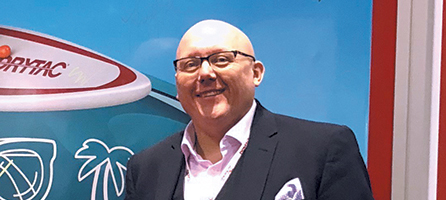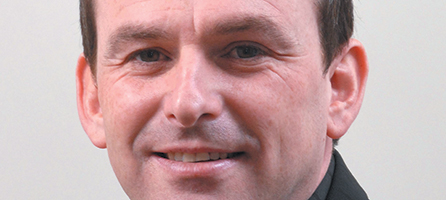
Steve Jacques, category manager, Spandex
Problem solved
In the world of signage, there is always a tricky application where a special material is required, whether this be for adverse weather conditions or for difficult substrates.
Most self-adhesive products need to be applied as close to room temperature (typically between 20 to 25°C) as possible. This is in order for the adhesive to develop a chemical bond with the substrate and deliver long-term process security, without the risk of delamination and/or shrinkage of the graphics.
But some installations, such as outdoor applications in winter, can potentially risk the integrity of the application due to the low temperatures. With this in mind, Spandex offers its range of competitively priced polymeric vinyls that can be applied at lower temperatures. Image Perfect 2553, 2554, and 2556 utilise a special adhesive technology, meaning they can be applied at 0°C without presenting any difficulties for the products to properly bond to the substrate.

Spandex offers its range of competitively priced polymeric vinyls that can be applied at lower temperatures”
Substrates with low surface energy or hard-to-stick surfaces such as soft, porous wood, can provide complications. Image Perfect 2558 Multi Grip has been engineered to provide a one-product-fits-all solution. IP 2558 utilises an aggressive adhesive system that will stick to even the most challenging surfaces, and the soft face film conforms to even the most heavily-structured substrate, such as brick wall or concrete. It also delivers excellent printability with fantastic colour contrast and does not have the high level of shrinkage that is otherwise typical for such products.
Whatever the application, there is usually a suitable product within the Spandex portfolio.
Put to the test

Ian Simister, sales director, Metamark
Modern self-adhesive materials are used in such a wide range of applications that they are exposed to all kinds of conditions. Fortunately, here at Metamark we have a group of technologists who are charged with making materials fit for purpose so that we can offer a trusted level of performance. When you are selecting materials, you do need to establish they are technically qualified for the job at hand.
Metamark materials are all tested in accelerated weathering systems. Those systems recreate in a lab, extreme conditions that might be encountered in actual real-world applications. The system exerts rapid temperature changes, blasts out UV light, and elevates humidity then parches the test piece again. Oddly, window graphics routinely experience just those conditions.
With our etch effect window films, we have formulated an Apex-Class adhesive, just for this application. It resists the conditions the application imposes on the material and does not ever disclose its presence. The adhesive on our etch effects never turns milky. We are pretty proud of that development.

Those systems recreate in a lab, extreme conditions”
We have also put a lot of work into the very fabric of our materials too. Some of the stuff that gets blasted the hardest is the wrapping film, our MD-X Meta Wrap. That undergoes extremes of elongation and gets hammered by wind and weather. It survives everything that comes its way. It stays looking great. This is primarily a quality effect. We could manufacture it for less, but then we would be compromising our performance and trust ethics.
Some durability battles are won in the test tube. Difficult, low energy surfaces, like the types of plastics you would find in moulded sports equipment like canoes, demand a very particular adhesive formulation. We have a product known as Metamark MDP-H. It was a real development challenge, but it achieves great things. You can stick it on a low energy surface and it will not peel or shrink. If you have ever seen a grubby black ring around an applied sticker on a plastic article, you know the sticker is not made with MDP-H.
No more hassle

Shaun Holdom, global product manager, Drytac
As with all things print, it is the application that should be considered first: where is the print going to be applied? How long does it need to stay there? What environmental factors need to be considered? Is the proposed site north or south facing? What are the lighting conditions? Will the print be exposed to high levels of UV? Is it likely to be exposed to heavy pollution? The list goes on.
Any extreme environment will have an impact on the longevity of a print, and the media used needs to be selected accordingly. But it is not just the media—it is finding the right combination of media, ink, adhesive, and overlaminate to address your specific requirement that will give the very best results.
Different media—vinyl, monomeric, and polymeric—has different shrinkage levels, so selecting the right product for your application is key. Due to production methods, polymeric vinyl shrinks less than a monomeric vinyl, and cast vinyl has zero shrinkage. These are all factors that need to be considered.

The right overlaminate needs to be selected and matched with the media and inks being used”
The type of laminate used is also key. The right overlaminate needs to be selected and matched with the media and inks being used. Some laminates, such as those offered by Drytac, have built-in UV inhibitors which will extend the life of a print. If you want longevity in an extreme environment, you should definitely consider Drytac’s Polar polymeric vinyl matched with Weathershield high-performance laminate with additional UV stabilisers.
Given that UV inks have a pile height on the print (and not a thin ink film like solvent or latex), the high coat weight adhesive helps with the lamination process of UV print and stops silvering and delamination. Furthermore, products such as Drytac’s Protac Glossy HCW laminate will add vibrancy to traditional matte UV inks, making the printed graphics really pop.
If you use the right materials for the right environment you will achieve a great result. You should always speak with your supplier and get as much information as you possibly can before you go ahead and prepare graphics for extreme environments.
Drytac offers a vast range of media (Polar, Hi Grab) and matched component overlaminates (Weathershield, Protac Anti-Graffiti) and by talking with the company, you can take the pain out of the whole process.
Failing to prepare…

Chris Green, channel head for visual communications, Antalis
As with most things, preparation is key; from practical preparation ahead of the job to physical preparation of the surface area and materials. Troubleshooting and anticipating problems and preparing solutions is important, especially when working in challenging environments.
Making time to visit the site beforehand can give you an advantage, as it allows you to inspect the surface and layout ahead of time and work out the best application approach, as well as pre-empting any potential conditional challenges or physical obstacles. You can also assess how much the existing surface area may need to be prepared.
The weather and changing conditions can have a significant impact when fitting rigid materials, so it’s important to take this into account when selecting a product. Heat and sun can also cause adhesives to dry too quickly, whereas colder temperatures can cause some materials to become brittle. It is therefore imperative to allow for expansion or contraction during application and to consider the life expectancy of the product you are using and whether it is suitable for the surface or conditions. Choosing a more durable product is generally preferable for this reason.

Making time to visit the site beforehand can give you an advantage”
To maximise any external print, it is always recommended that you laminate in order to protect and enhance the finished result. If you are creating long-term graphics and want to install them outdoors, they need protection from UV light and the general wear and tear of weathering. The inks that large-format graphics are printed with have a lifespan of two to three years. Lamination extends that significantly, so it is vital for longer term end uses.
One product ideal for outdoor use is Stadur Sign SF. Made from rigid PVC skins over a polystyrene centre, Stadur SF is a lightweight and rigid foam composite which offers wide creative scope. Among other advantages, it is easily printable with screen printing and UV curable inkjet printers, offers vivid print results, and is weather and moisture resistant for up to two years with outdoor use. It is also so robust that it will not crack, shatter or break, and stands perfectly rigid without any flex or bend.
When tackling applications in challenging environments, it is always a good idea to get advice from an expert on product selection and application techniques to minimise any potential issues on the day.
Your text here...